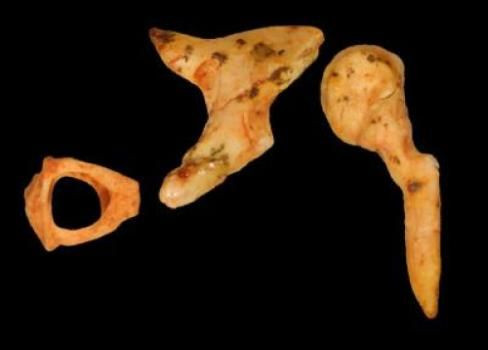Were Ancient Hominins Hearing Sounds Differently Than Modern Humans?

Early ancestors of modern humans probably heard differently than we do, suggests a study on the oldest complete set of hominin middle ear bones ever found in one skull.
After analyzing the middle ear bones in a 1.9 million-year-old skull from the extinct early hominin species Paranthropus robustus, as well as another incomplete set from Australopithecus africanus, researchers discovered structures with a mix of ape-like and human-like features.
Analyses of the fossils, which were found in South African caves called Swartkrans and Sterkfontein, were published on May 13 in the journal Proceedings of the National Academy of Science (PNAS) by researchers from Texas A&M University as Binghamton University, as well as others in Italy and Spain.
The malleus, incus, and stapes bones of the middle ear, called the auditory ossicles, are the tiniest bones in the human body. Commonly known as the hammer, the anvil, and the stirrup, vibrations of these bones allow us to hear by transmitting sound frequencies through our ears.
Because the ossicles are so small, it is extremely uncommon for them to be preserved in fossils of ancient hominins.
"They are among the rarest of fossils that can be recovered," said researcher Darryl de Ruiter, an anthropology professor at Texas A&M University, in a news release.
Middle Ear Bones Reveal Early Hominin Genetics
Auditory ossicles are uniquely indicative of genetic expression, said de Ruiter, because they are fully formed and adult-sized at birth. Because they do not typically change throughout an individual's lifetime, fossil samples of ossicles can reveal a great deal of evolutionary information.
In the case of both the Paranthropus robustus and Australopithecus africanus samples, researchers found that two of the three ossicles, the incus and the stapes, resembled those of modern African and Asian great apes like gorillas, chimpanzees, and orangutans. However, the third bone, the malleus, was strikingly like that of a modern human.
This might mark one of the earliest human-like features in the fossil record, write the researchers— changes to the malleus ear bone are probably a defining feature that occurred deep in the evolutionary history of our species.
"Bipedalism (walking on two feet) and a reduction in the size of the canine teeth have long been held to be 'hallmarks of humanity,'" said de Ruiter, because these qualities are apparent in the oldest human fossils that have been examined thus far.
"Our study suggests that the list may need to be updated to include changes in the malleus as well."
Ancient Human Ancestors Had Different Hearing Capacities
The recovered ossicles are also important because they may reveal to us how these human ancestor species heard the world.
While this study doesn't prove it, the bones suggest "that their hearing ability was different from that of humans— not necessarily better or worse, but certainly different," said de Ruiter.
The auditory ossicle structures were somewhere between ours and those of modern great apes, so it's possible that, much like chimpanzees, these early hominins would not have easily heard the acoustic frequencies of modern human speech.
"Anthropologists are in general agreement that these early hominins likely did not possess spoken language," researcher Rolf Quam of Binghamton University told New Scientist.
The researchers expect to study how Paranthropus robustus and Australopithecus africanus heard sounds by virtually reconstructing their middle ear bones in 3D with CT scans.
That method previously allowed the same team to compare the hearing patterns of Neanderthal ancestors to those of anatomically modern Homo sapiens.
Citation:
Rolf M. Quam, Darryl J. de Ruiter, Melchiorre Masali, Juan-Luis Arsuaga, Ignacio Martínez, and Jacopo Moggi-Cecchi. Early hominin auditory ossicles from South Africa. PNAS, May 13, 2013 DOI: 10.1073/pnas.1303375110



























